-
TO HAVE AND TO HOLD - Collecting Craft
Shown above: ‘Shararah’ at the Victoria and Albert Museum by Ashraf Hanna, ready for the opening of ‘Contemporary Ceramic Art from the Middle East’. Image Petter Kelleher
Last week, ceramicist Ashraf Hanna installed his latest work, a 25 piece installation titled, ‘Shararah’ at the Victoria and Albert Museum, ready for the opening of ‘Contemporary Ceramic Art from the Middle East’. This installation arose from a conversation between the curator of the V&A’s Middle Eastern section, Dr Mariam Rosser-Owen, and Ashraf about the similarities between some of his earlier work and the V&A’s collection of 19th-century burnished ceramics from Asyut in Upper Egypt. Ashraf is originally from a neighbouring region in Egypt and being involved in this exhibition has been a wonderful opportunity for the artist to make a body of work specifically engaging with both the Asyut collection and his Egyptian heritage.
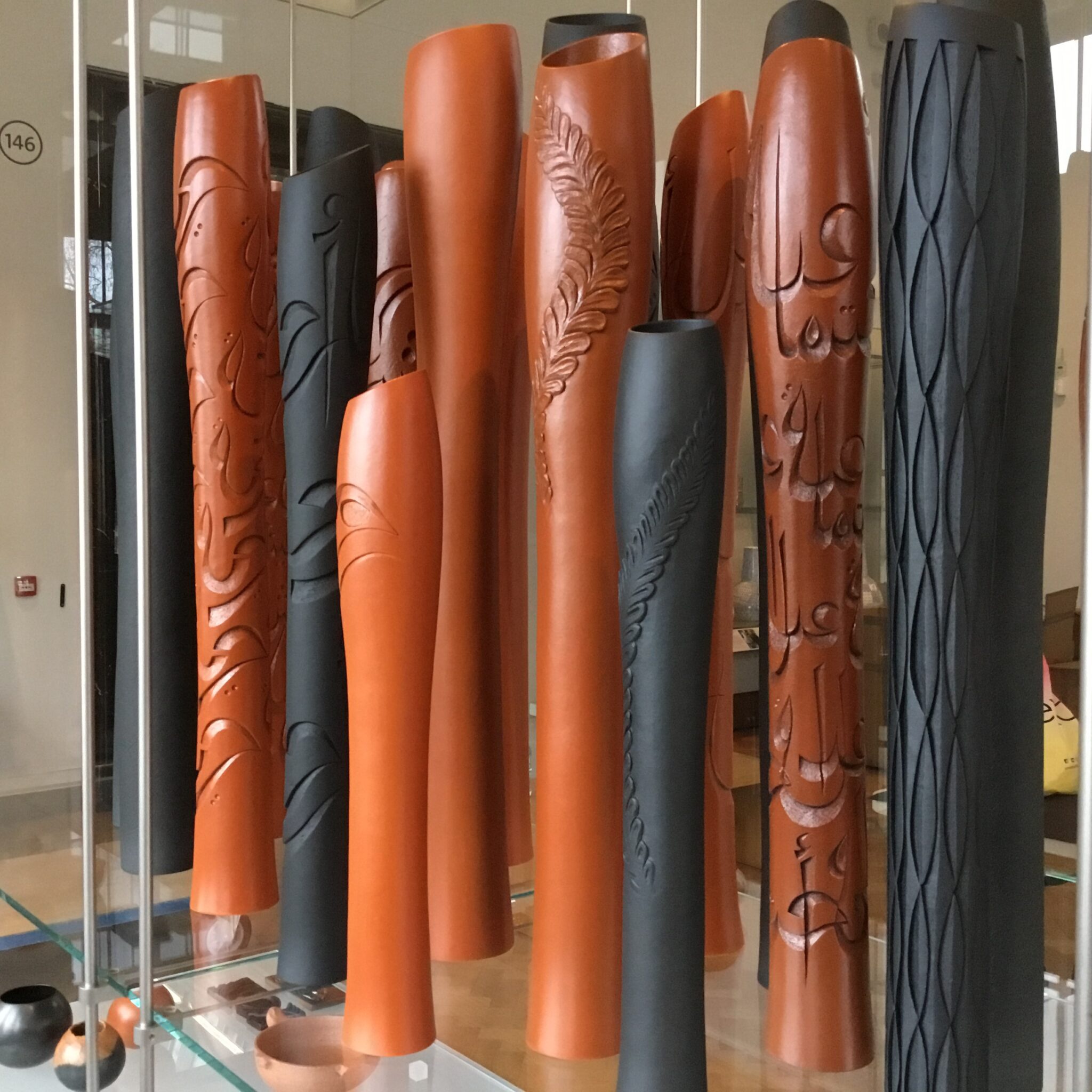
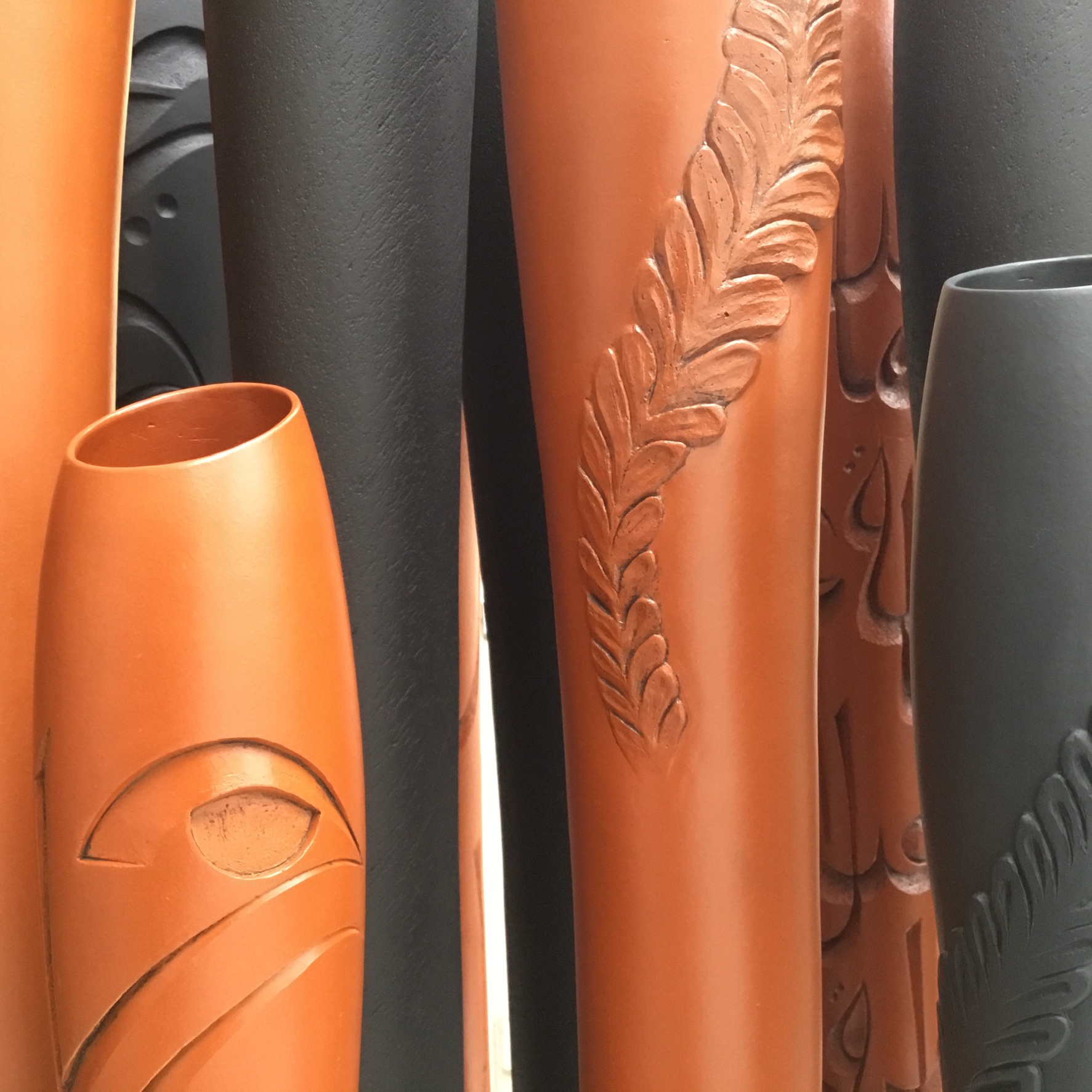
“Today perhaps the greatest accolade you can give a work of art is to say it is of ‘museum quality’.”
Grayson Perry (Playing to the Gallery, Penguin 2014)
Ashraf is one of many artists in the Cavaliero Finn portfolio whose work has been acquired by or featured in a museum. In the past three years alone, Ashraf’s work has been acquired by The Victoria and Albert Museum, The Fitzwilliam Museum in Cambridge, Swindon Museum and Art Gallery, and the Aberystwyth Art Centre at Aberystwyth University in Wales. This week, we take a look at those artists featured in the current collaborative show, Crafting a Difference at SoShiro, whose work is in public collections and we consider what it is about these artists’ work that makes it collectible.

Ashraf Hanna, Storm Beach I, installation of 56 ceramic vessels, 250 x 45 x 45 cm – sold
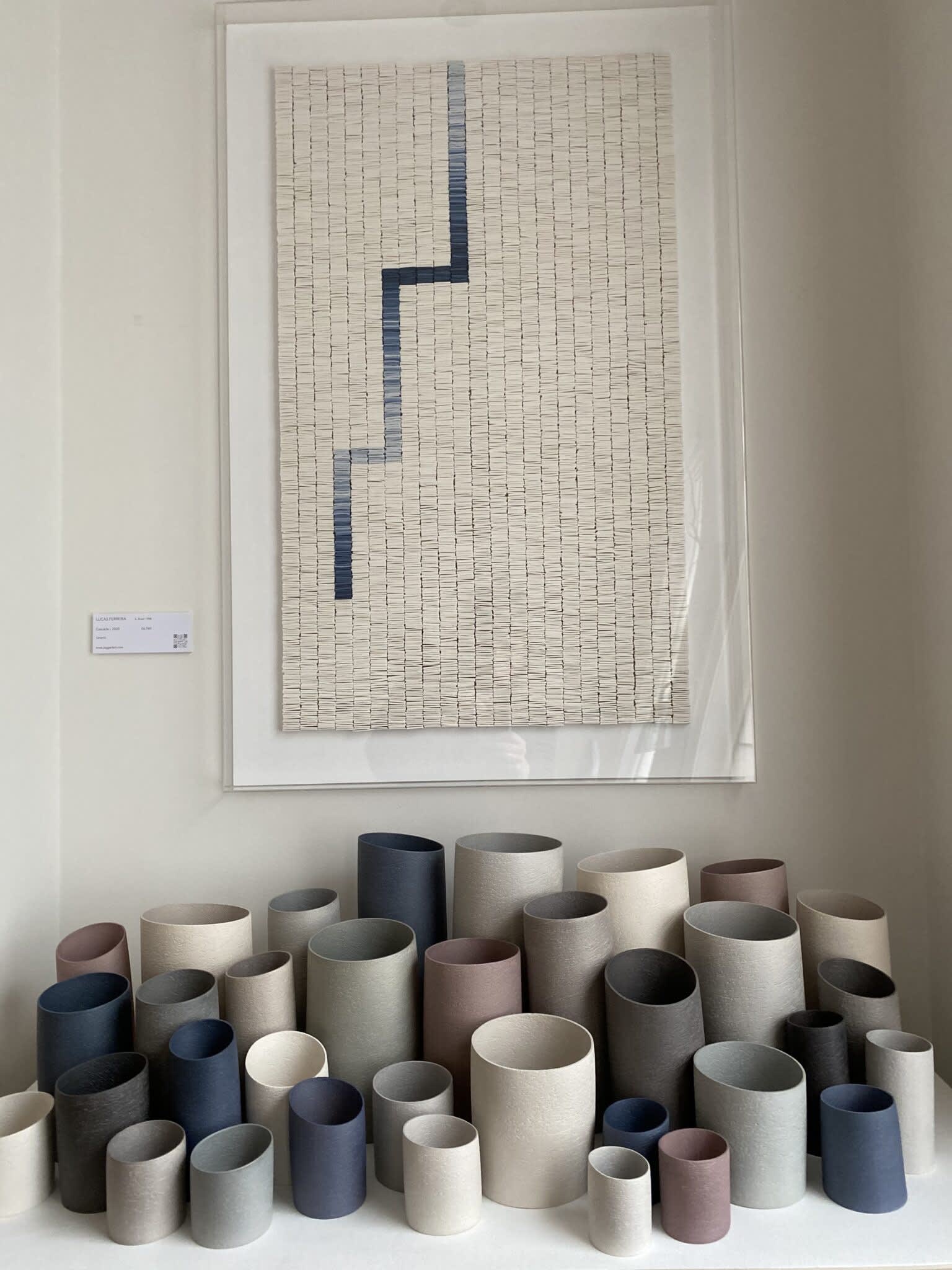
Ashraf Hanna, Storm Beach II, installation of 34 ceramic vessels, 120 x 45 x 45 cm, 2020
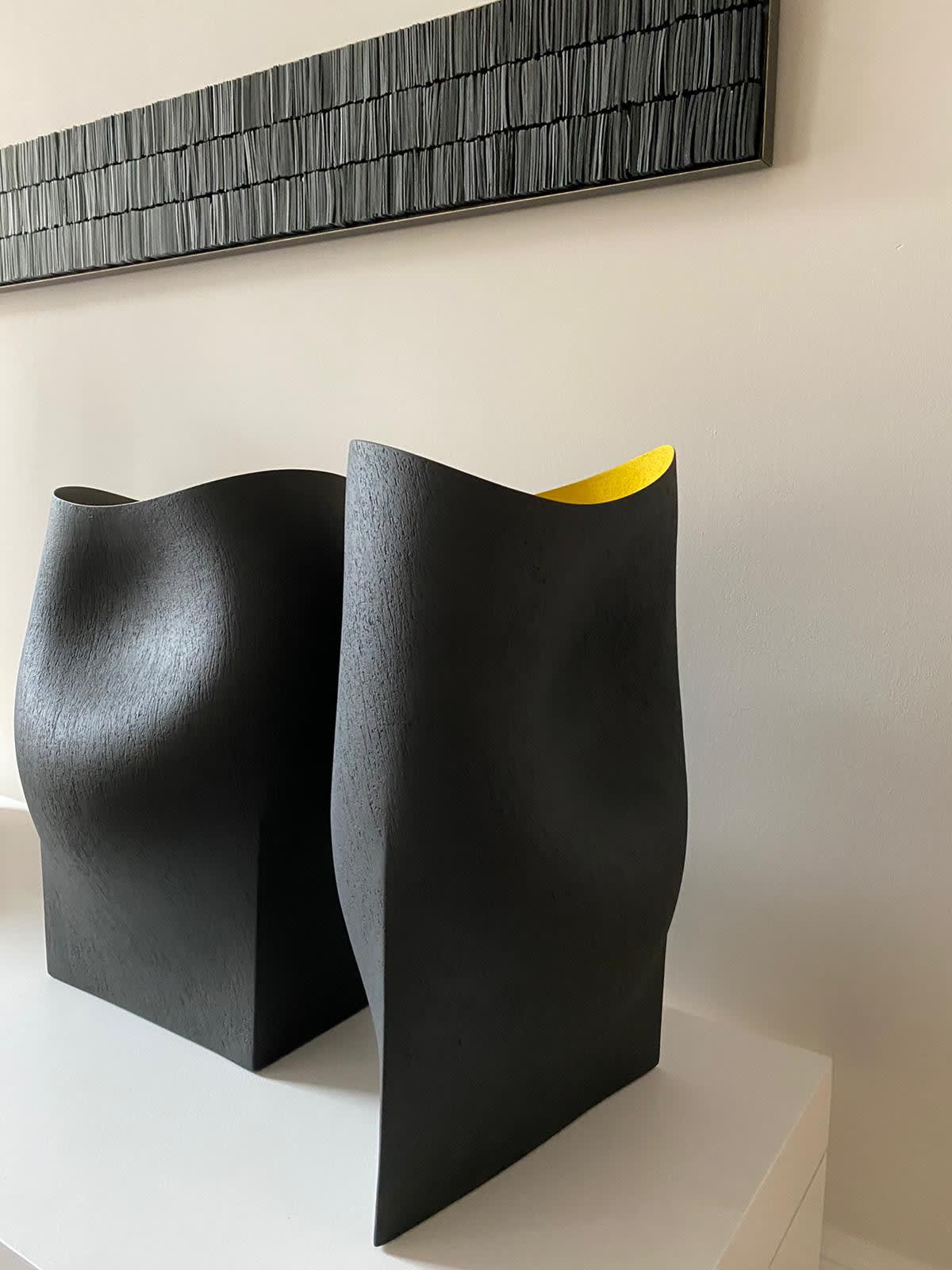
Ashraf Hanna, Black and Yellow Undulating Vessel, ceramic, 39 x 23 x 16 cm, 2020
Ashraf Hanna, Black and Grey Undulating Vessel, ceramic, 37cm H, 2020 – soldThere has been a huge shift and leveling in the art market over recent years, with a distinct rise in interest in and the sale of craft. According to the Craft’s Council’s report – “The Market for Craft”, since 2006, the total value of craft objects sold in England has gone from £883 million in 2006 to over £3 billion in 2019. As a gallery, Cavaliero Finn has always exhibited a broad range of artworks from a variety of disciplines including ceramics, paintings, sculpture, textiles, and design; no discipline is given any more status than another. Our curatorial selection is generally led by two key factors – the work must have a strong narrative that speaks to both of us and it must be technically advanced.
“As an Egyptian, the last 10 years have been momentous, since the revolution of January 2011, Egypt has been through a great deal of upheaval.
“Carved at the core of ‘Shararah’ are the slogans of the revolution (Bread, Freedom, Social Justice) repeatedly chanted by the youth who sparked the demonstrations.
“The revolution of 2011 was by far the most significant moment for me and for many Egyptians who have longed for change. Initial euphoria and optimism gave way to despair and frustration by the events that followed in Egypt and the wider Middle East.
“‘Shararah’ (spark) is a 25 pieces installation marking the date the revolution started and is my personal tribute to the young men and women who dared to dream. Thousands have paid a very heavy price, many have indeed paid the ultimate price.”- Ashraf Hanna, speaking about his latest work for the V&A exhibition.
Like Ashraf, all of our ceramicists have a very sound understanding of and expertise in traditional techniques. They use this knowledge and expertise to push clay to new extremes, mixing methods and honing techniques to bring to life distinctive, sculptural artworks. This is one of the reasons their work excites us and why it is sought out by collectors and museum curators, worldwide.
-

Ikuko Iwamoto from Cavaliero Finn photographed by Alun Callender for Cox London
Ikuko Iwamoto uses a combination of slip-casted and hand-crafted porcelain to create her exceptional, intricate artworks. Her work is extremely labour intensive with some of her larger pieces taking months to make.
Talking about her work in a recent feature about Ikuko in Ceramic Review, journalist Jane Audas said:
“For Iwamoto, slip-casting porcelain (she uses Valentine Clay’s special porcelain slip from Stoke-on-Trent) is a means to an unusual shape, rather than an opportunity to mass-produce anything. She is using it in a fine art way to make sometimes just one unusual shape, or a structure that she couldn’t get from hand-building:
“My first goal is making the shape I really want to show, that is my first priority,” Ikuko explains. And it is her love of form that keeps her colour palette minimal, too."
“I don’t normally use colour because I love the structure and I like the fact that the shadows (of the spikes) can affect the colour of the piece.”
Read the full Ceramic Review article here
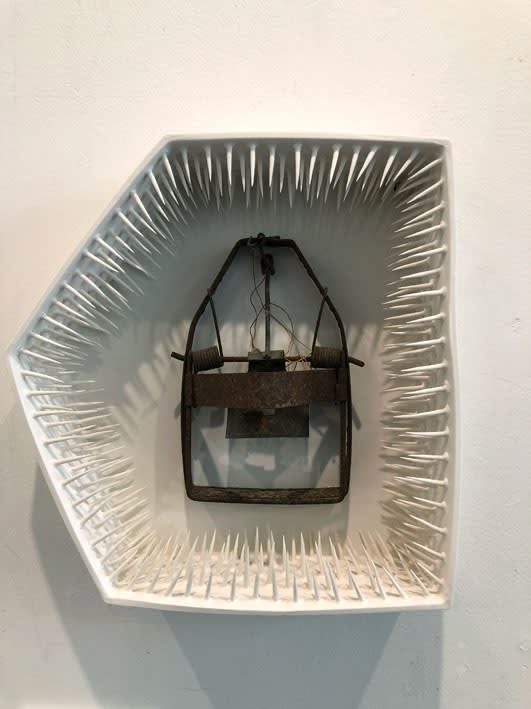
Ikuko Iwamoto, Trapped Trap, porcelain and antique trap, 40 x 32 x 9.5 cm
In the latest edition of Crafting a Difference a series of wall hanging sculptural works have been created using a range of antique, found objects combined with Ikuko’s trademark spiky attachments. Talking about this body of work Ikuko said:
“Each antique object I work with is handcrafted and has got individual character and history. I tend to work with functional objects that would have had an everyday use, so, domestic tools for the garden and kitchen for example.
“I have always thought that porcelain’s natural white colour is a perfect match for these kinds of objects, and I imagined that adding an extra dimension to them, would make them even more exciting.
“It’s more about adding than creating from the beginning with this project, and because the spike attachments are more ornamental, they were a natural choice for me. The addition of gold lustre elevates the functional status of the antique objects further into the ornamental domain.”Ikuko has a very loyal following with clients as she continues to expand her body of work producing inspiring and totally unique artworks that keep collectors and us, as curators, constantly in awe of her technical and creative prowess. Ikuko’s work has been acquired by the Victoria & Albert Museum, London, Touchstone, Rochdale, and the Manchester Art Gallery. In 2019 she was awarded the Young Masters Maylis Grand Ceramic Prize for her framed sculpture A Crescent in Downs Park, 2019, Porcelain, Hypodermic Needle, Coiled Cable, Toothbrush, and Tape Dispenser.
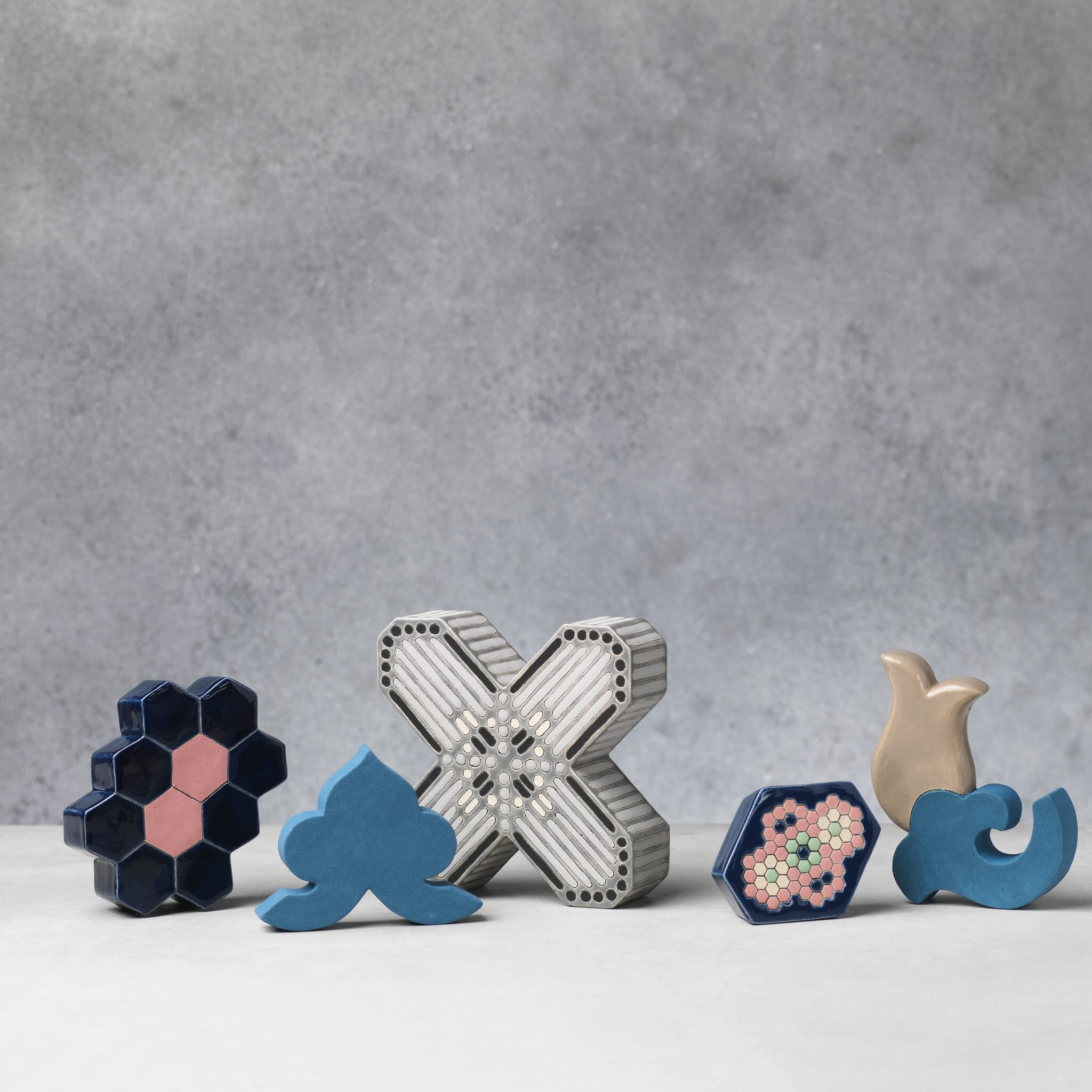
Frances Priest: Collection – Kirkcaldy Patterns III, 5 handbuilt ceramic forms, inscribed line, earthenware glaze and vitreous slip, tallest piece 13cm, 2021 Frances Priest’s current work explores and interprets languages of ornament from different cultures, places, and periods in history. Her latest work responds to the manufacturing heritage of the Scottish town of Kirkcaldy, once renowned for linoleum and ceramic manufacturing. Delving into the decorative past of this Scottish Town has revealed a cornucopia of design influences from across the globe. The motifs in the works are drawn directly from industry pattern books and original examples, re-interpreted as five-piece, sculptural compositions in ceramic that are made to be handheld and rearranged.
In addition to the playful nature of creating a sculpture that can be rearranged, there’s a wonderfully playful narrative behind the design. Each of the intricate, ceramic pieces originate from linoleum which was itself designed to mimic more ornate ceramic tiles. Frances breathes new life into the design, bringing it back full circle to a ceramic form with a different purpose, so in this sense, the patterns/motifs become a continuation of The Grammar of Ornament.
Frances’ work is collected worldwide and has been acquired by the following museums; The National Museums of Scotland Edinburgh, UK 2003 & 2018, The Fitzwilliam Museum Cambridge, UK 2004 & 2018, The Victoria & Albert Museum London, UK 2006, McManus Galleries Dundee, UK 2005, The Shipley Art Gallery Gateshead, UK 2002, The International Museum of Ceramics Faenza, Italy 2001 and The International Museum of Contemporary Ceramics Ichon Province, Korea 2001.
Read our interview with Frances to find out more about her work.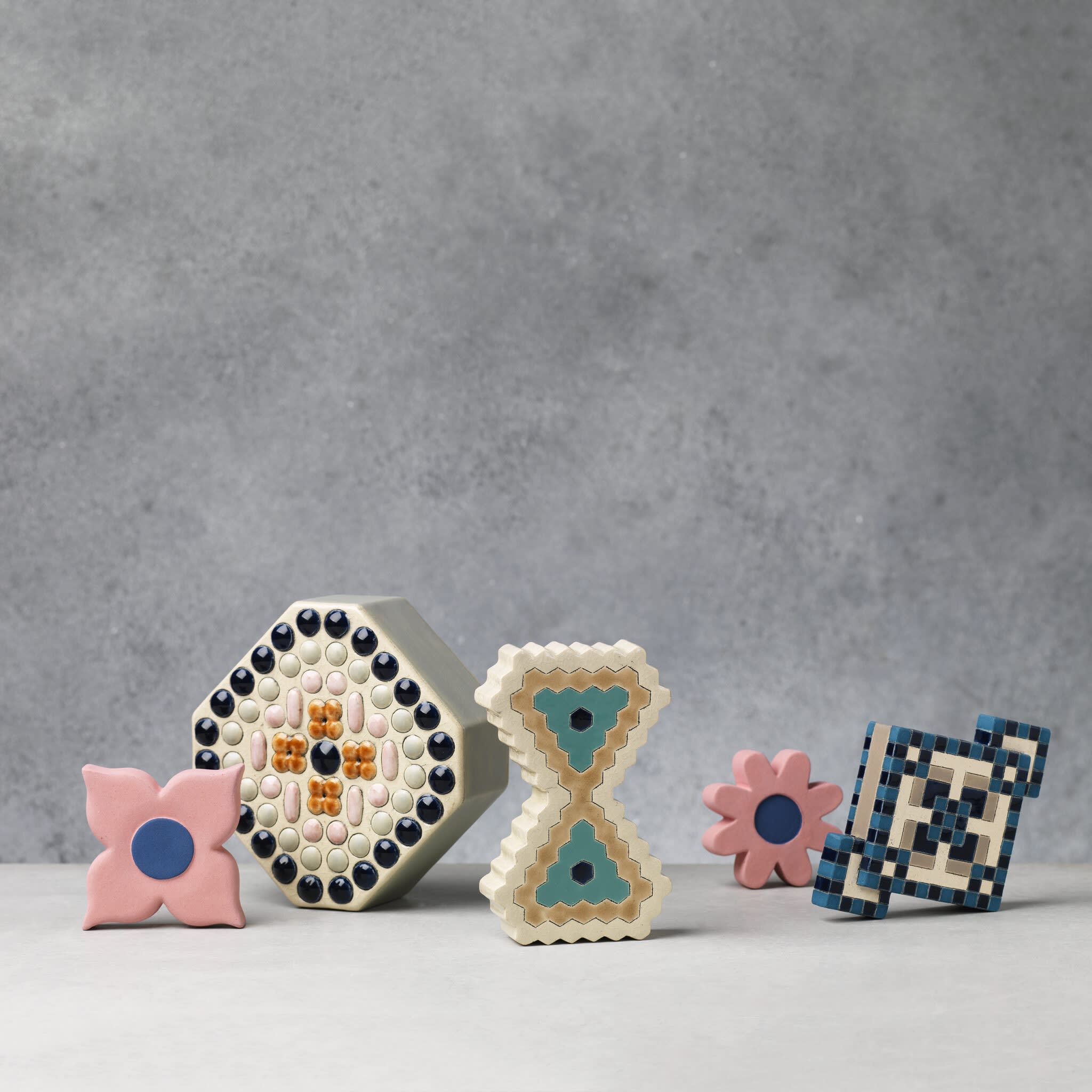
Frances Priest: Collection – Kirkcaldy Patterns IV,
5 handbuilt ceramic forms, inscribed line, earthenware glaze and vitreous slip, tallest piece 14cm 2021
Loewe Craft Prize finalist Annie Turner creates ceramic sculptures which are very closely linked with the River Deben in Suffolk and its surrounding environment where the artist grew up. The river’s past and present, the cycles of nature, and the interaction of man are at the heart of each encrusted sculptural form she creates. These are, as she puts it ‘objects that trigger the memory’, as much collective memory as personal recollection.
Annie’s work is exceptional on so many levels, but especially on a technical level. Its construction and process is so labour intensive. Unlike the work of many of our other artists, Annie uses the kiln to encourage the bending and collapse of the forms she creates. Through years of mastering her craft, she knows exactly how to in-build the weaknesses and strengths of her ceramic forms so she can promote a lot of movement or very little whilst they are in the kiln. It was no surprise to us that she became a Loewe Craft Prize finalist in 2019.
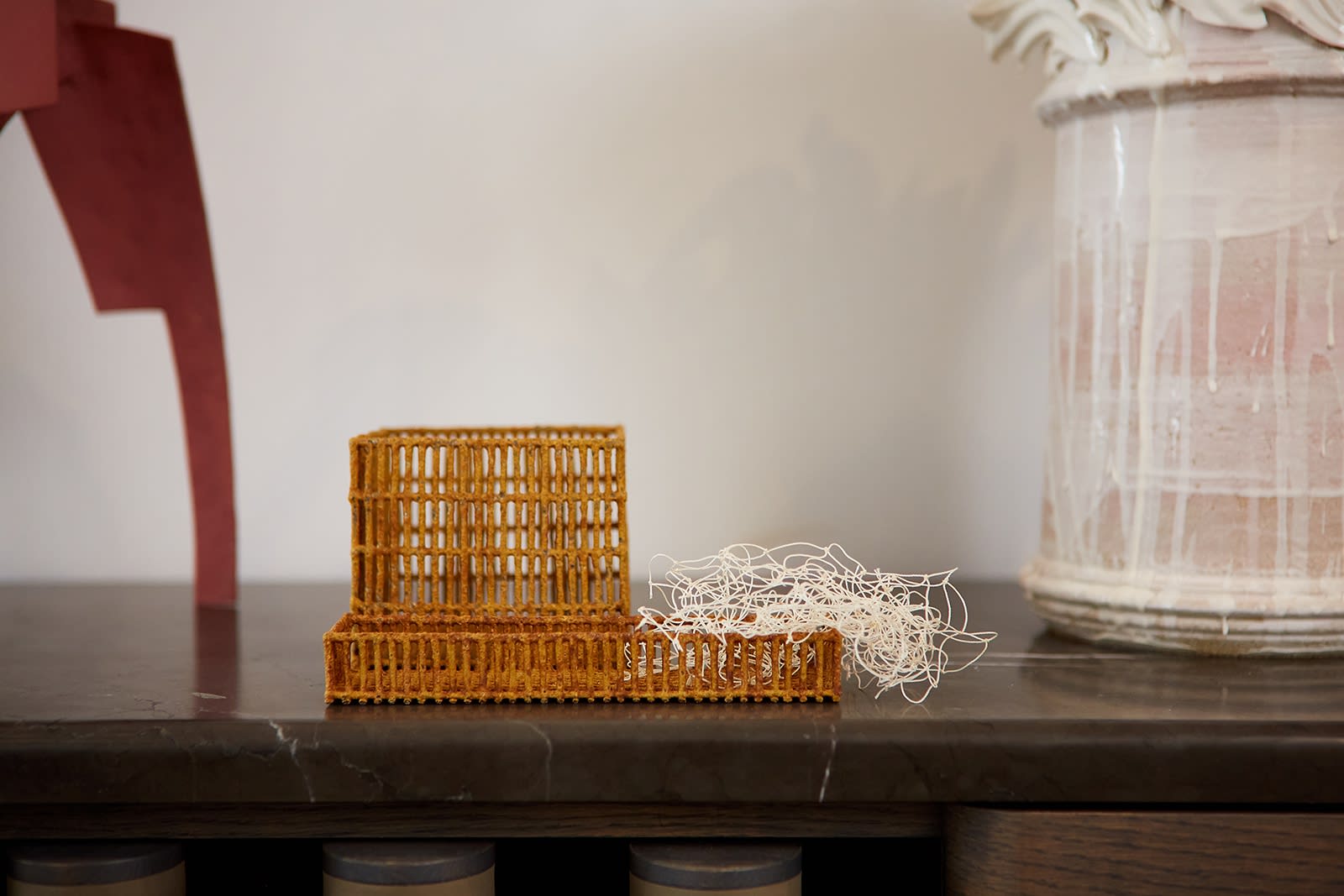
Annie Turner: Swan’s Nest Sluice and Needle Box and Herring Net, 2021 (both sold)
Image by Robert ChadwickWriting about Annie Turner’s ‘Net’ (2010), given to the Fitzwilliam Museum Cambridge by Sir Nicholas and Judith Goodison, in Ceramic Review, Curator, Helen Ritchie said:
“Even at a distance, some objects resonate more than others, conveying a strong sense of identity, time, or, in this case, place. Annie Turner’s work is fundamentally connected to the River Deben, in Suffolk, with which she has a lifelong connection. Turner has described her net sculptures, with their architectural element, as suggesting, ‘ladders that climb and jetties that cross, the sluices which pass through the river walls and the sinkers’. As I spend lockdown in a city flat, Turner’s work acts as a conduit to open, wilder space, where there is more room to breathe.”
As well as the Fitzwilliam Museum, Annie’s work is in the permanent collections at the Shipley Art Gallery, The National Museum Of Wales, Cardiff, The State University Buffalo New York U.S.A, The Grainer Collection U.S.A, and The Victoria and Albert Museum.
All of the work that we are featuring at Crafting a Difference by Annie Turner has now sold.
If you would like to read more about Annie’s work check out our interview with the artist here.
-
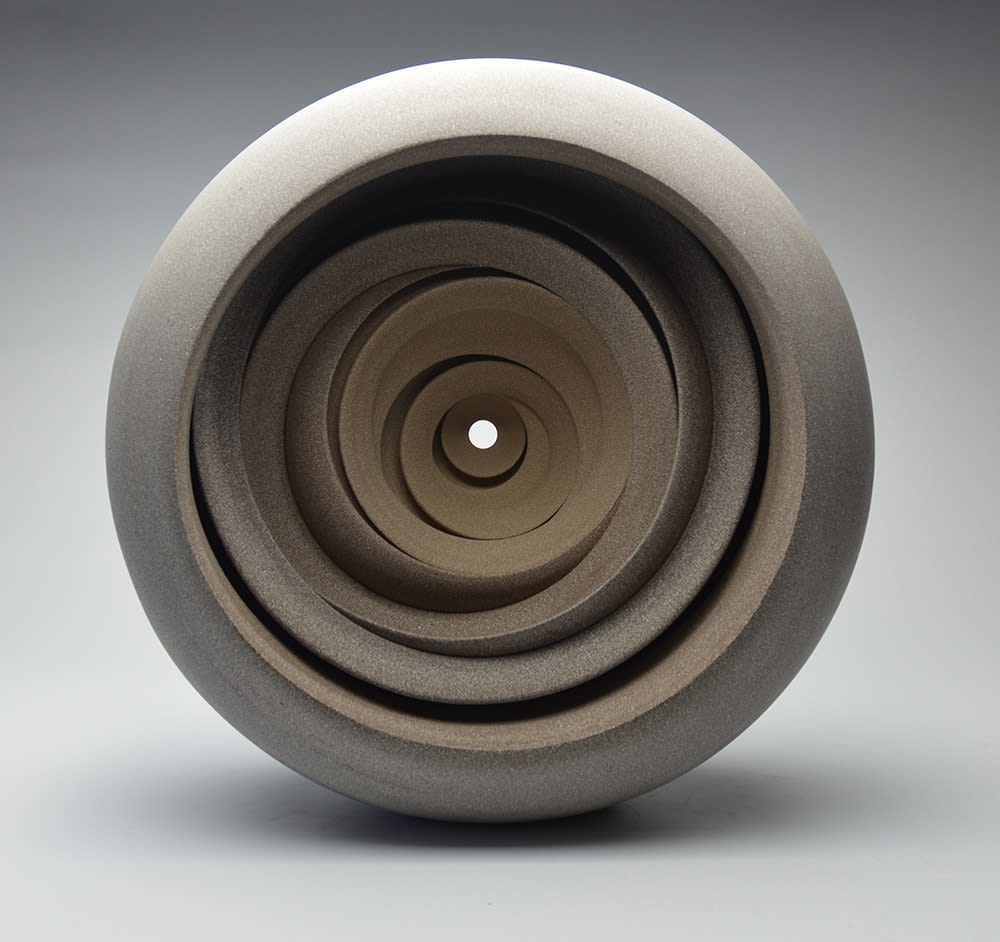
Matthew Chambers, Twist Inside, 35cm diameter, Stoneware and oxides, 2020 Talking about Matthew Chamber’s ceramic sculptures in FT How to Spend It, actor James Nesbitt, said:
“I look at this piece with real wonder and hope. There is an endless, integral beauty to it that I find very moving. It’s extraordinary. Almost wondrous.”
James Nesbitt, actor FT How to Spend it May 29th, 2020
This is a typical response from clients who, like James, have bought Matthew Chamber’s sculptures from Cavaliero Finn over the years. We love to see the reaction of people seeing Matthew’s work for the first time. You can physically see their mouths drop, while they wrack their brains, trying to work out how on earth his circular sculptures are made. Aside from their undeniable beauty, they are technically astounding and totally unique, which is why we have worked with Matthew for over 15 years.

Matthew Chambers: Earth Red Slow Twist, 38cm, Stoneware, 2020 In his recent talk – Collect Selects Ceramics and Glass for the VIP programme of art fair Collect 2021, Sotheby’s Director, Robin Cawdron Stewart talked about his love for Matthew Chamber’s work:
“His pieces are magnificent….Matthew’s work is unique in the context of British ceramicists at the moment. He treads such a fine line between ceramics and sculpture… his work is so accessible. He’s a good name to watch.”
Matthew’s work can be found in public collections in the Fitzwilliam Museum, Cambridge and National Museum, Scotland, Musée National de Céramique de Sèvres in Paris, and the Musee Ariana in Geneva. In 2019 the Victoria and Albert Museum purchased one of Matthew’s sculptures for their permanent collection from Cavaliero Finn’s showcase at Collect.
Find out more about Matthew’s work in our recent interview with the artist here.
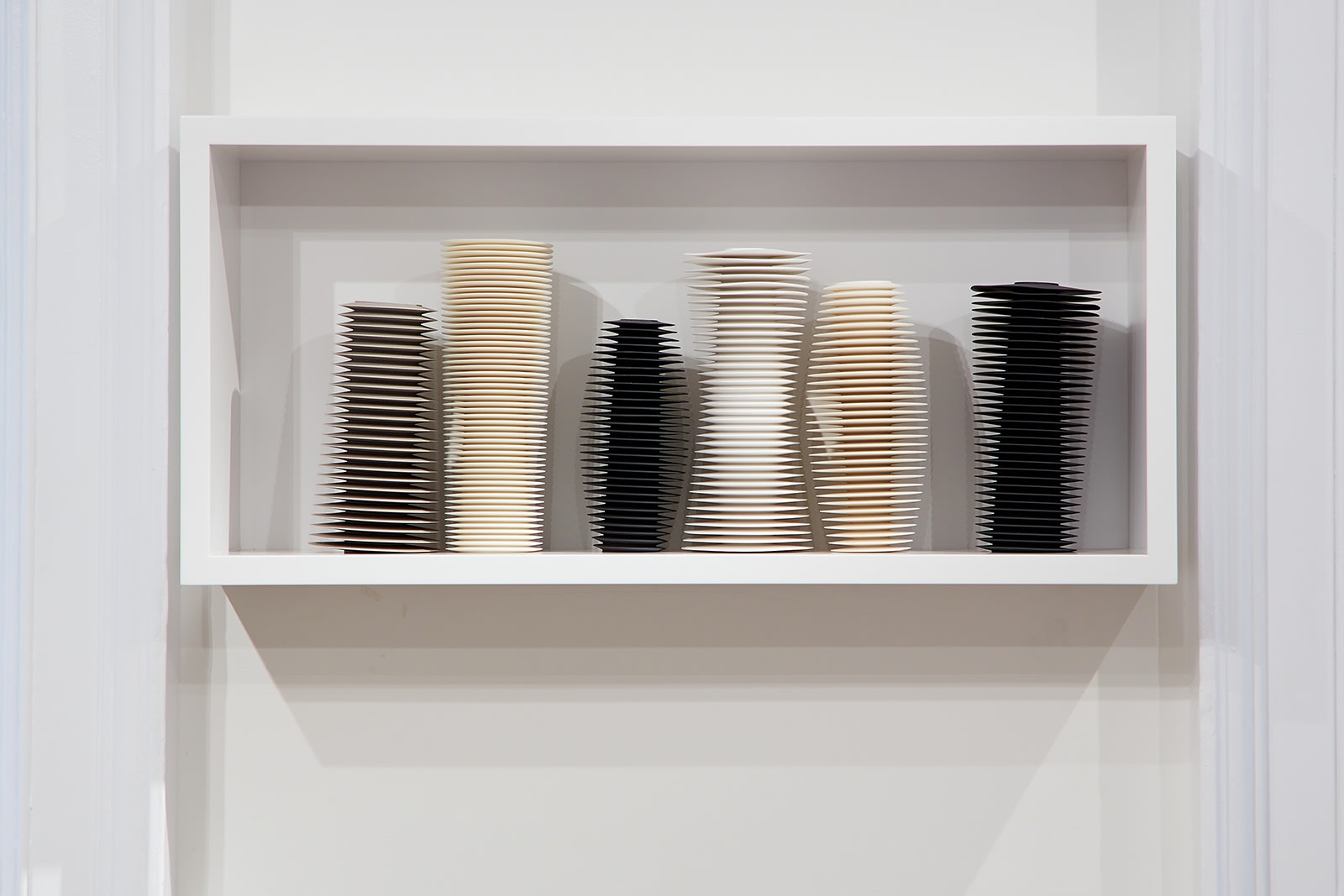
Nicholas Lees: Six Piece Framed Installation, 21.18, H 40 x W 85 x D 20cm, Parian, grey Parian, bone china, black porcelain, painted fibreboard, 2021 At the end of 2019, Nicholas Lees exhibited three of his cobalt blue floating bowls with us at Alter at Fitzrovia Chapel. The rather exceptional trio was acquired for the permanent collection of the Fitzwilliam Museum in Cambridge at the show, courtesy of Nicholas and Judith Goodison.
In addition to this, Nicholas’ work has been exhibited widely in the UK and overseas and is held in private and public collections including York City Art Gallery, York, Keramikmuseum Westerwald, Höhr-Grenzhausen, Germany, Museo Internazionale delle Ceramiche, Faenza, Italy, and the Auckland Museum, Auckland, New Zealand.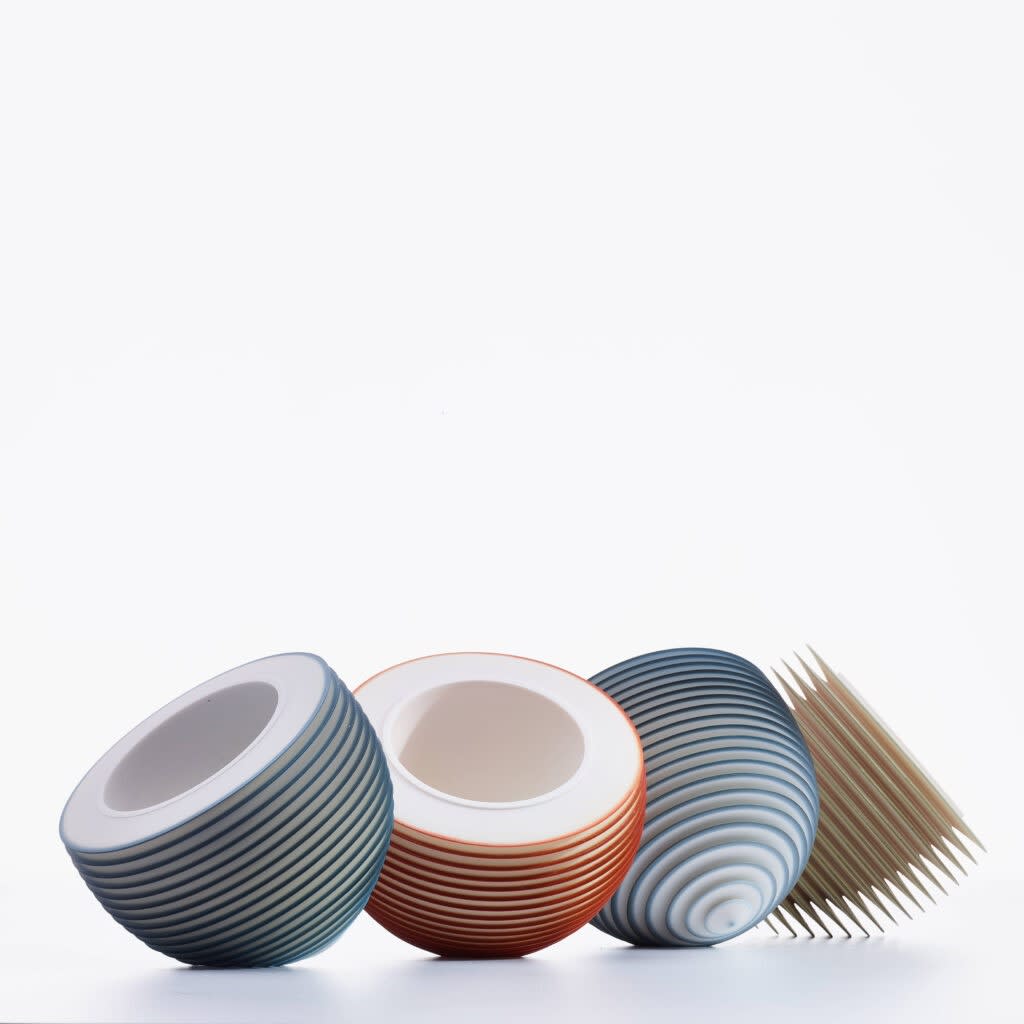
A series of small floating bowls by Nicholas Lees Like many of our artists, Nicholas’s approach to his craft continues to be an investigative journey.
This in itself makes his work attractive to collectors as he pushes the possibilities of the materials he works with to create new and innovative bodies of work.Talking about his coloured Floating Bowl series Nicholas recently said:
“The introduction of colour to my sculptures was inspired by my works on paper with ink. I started experimenting with soluble metal salts to colour the ceramic as opposed to working with glazes and oxides, for example. This is an unusual technique, and I was trying to mimic the way that ink soaks into the paper. I found that if I worked with a solution of Cobalt Sulphate applied to the interior of the biscuit fired sculpture and then saturated it with water, as the sculpture dried the colour moved through the sculpture and concentrated onto the edges of the ‘fins’ I’d created using the lathe. The Cobalt moved to the edges of the sculpture because there was a suction caused by faster evaporation from those edges. It was really quite beautiful and everything I was trying to achieve."
“Recently I’ve added soluble gold, copper, and iron to my investigations, which has been another exciting development for me. The colour is all dependent on the chemical interaction between the metal and the porcelain clay. I hope to move on to new metals as well as exploring the possibilities of combining the metals and using them with different clay bodies to achieve different colour results. The process is slow as tests have to be done on finished works which, in themselves take time to make as you can see in the video, but it is a necessary part of the making in order to understand how the effects work.”Watch Nicholas making one of his floating bowl series here.

Akiko Hirai, Mini Moon Jar. stoneware, porcelain, white glaze and wood ash, 22 w x 29 h cm, 2021 (sold) Another artist who uses metals in her clay, like Nicholas Lees, and who works with the temperature of the kiln to encourage further changes to her work whilst firing, like Annie Turner, is Akiko Hirai, and she does this to perfection. Akiko was also a Loewe Craft Prize finalist in 2019 and her work has a worldwide following. Her work has been acquired by the Victoria and Albert Museum, London, the Fitzwilliam Museum, Cambridge, and the Keramikmuseum Westerwald (Westerwald Ceramic Museum), Germany.
Talking about the making of her moon jars which we featured during Crafting a Difference (now all sold) she explained a little of her process.
“Using stoneware, I make the bottom half of the moon jar by throwing a pot on the wheel, I then make the top part by coiling. The original moon jar was made with two large thrown pots joined together but I like the feeling of growing the top part so I prefer not to join an upside-down pot as the upper part. The base of the moon jar is substantial, to withstand the weight of the top of the form and the layers of texture I add later. When the rim of the moon jar is complete and the complete shape is made, I distress the rim. I do this in the same way as when something is broken, people tend to complete it in their imagination, so it is important that the form is initially made perfect."
“The surface of the moon jar is made by applying a layer of dark slip and 3 different types of white slips and lastly fine bits of porcelain are applied on top. I then bisque fire the moon jar.“My glaze is basic white/blue. Finally, I apply wood ash partly on the glazed surface. I only use one type of glaze but due to the chemical reactions in the reduction firing process which reduces the amount of oxygen in the kiln, it creates specific colors and textures to the pot. Some of the added materials are organic substances that burn away after the firing, some are metals and minerals that change their properties and react in the high heat and reduction process."
“During the glaze firing, I start the reduction around 1742°F (950°C). I operate the burner somewhat unevenly so that part of the kiln gets slightly cooler to make a diverse surface. Sometimes I heavily reduce the kiln to the end of the firing, and sometimes I lightly oxidize the kiln atmosphere at the end, depending on my desired outcome.”Find out more about Akiko’s work by reading our interview with the artist here.
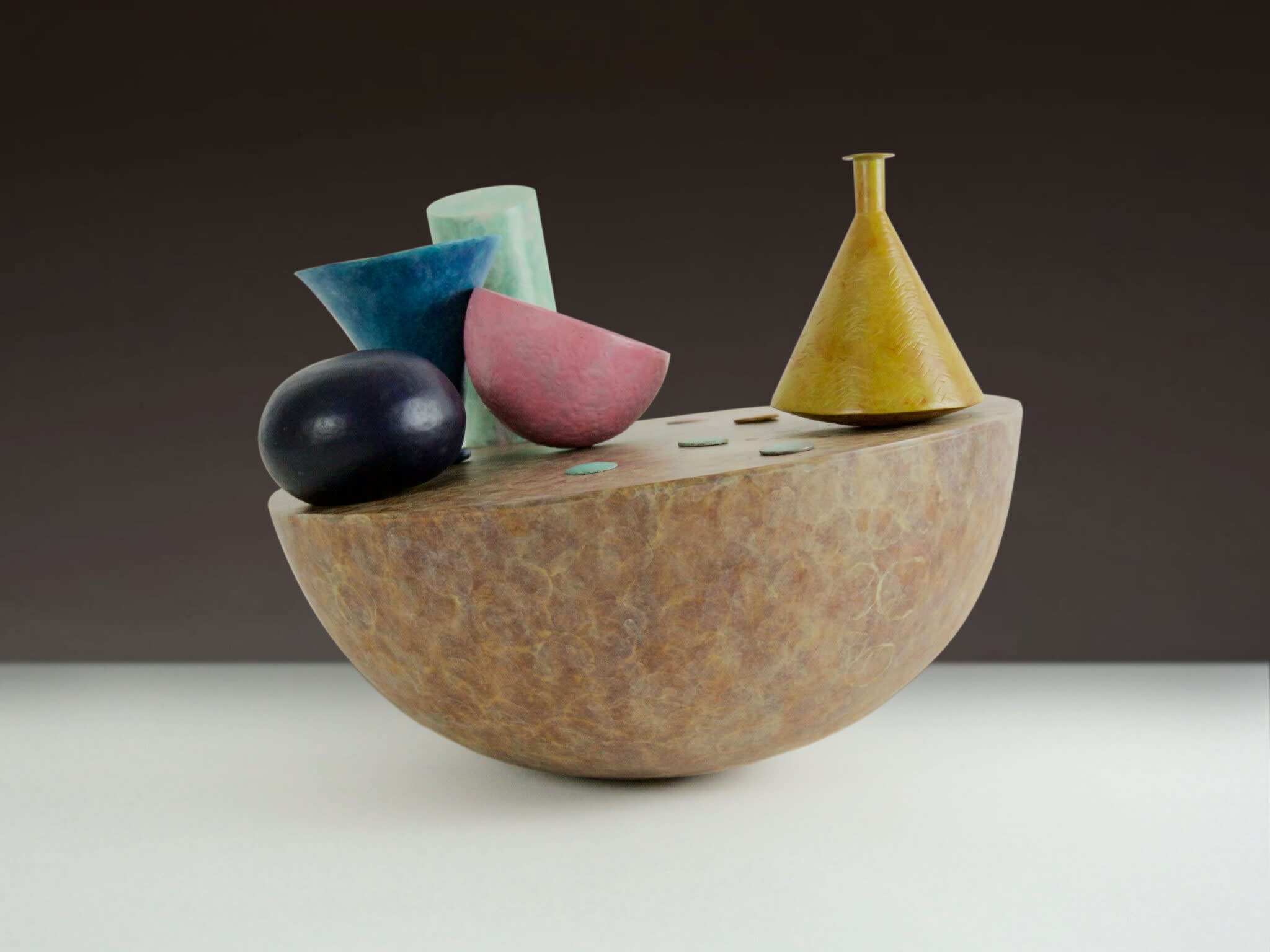
Balancing Act I – Copper, brass, bronze,”nickel silver”
Techniques: raised, soldered, constructed, etched, engraved, patinated.
Components: copper bowl, 7 top pieces, 7 pins, comes with a mahogany stand to store the pieces. Dimensions: diam 26cm x h.11cm + top pieces h.5 -14cm, Wooden stand: 30 x 9 x 9cmYou may have read last week’s post featuring our interview with Cecilia Moore, suffice to say Cecilia’s exploration of ancient metalworking techniques such as raising and her incredible understanding of the chemical reactions of the metals she works with means that she is able to bring to life her joyful and distinctive sculptures.
Her latest work, Balancing Act I and II, featured in Crafting a Difference at SoShiro is inspired by Morandi’s still life paintings. Cecilia creates a mottled and lined finish to the surface of each handcrafted element of the sculpture through patination to replicate the painterly feel of Morandi’s work.
Cecilia’s work has been selected for numerous national and international exhibitions, and is in public and private collections, including the National Museum of Ireland, the State Collection of Ireland, and the National Irish Visual Arts Library. She has completed several public art commissions and been selected for Design and Crafts Council of Ireland’s “Critical Selection” from 2017-2020. In 2018 she won the Golden Fleece Award a major national prize for visual artists in Ireland; in 2016 she won the Royal Dublin Society Award for Silversmithing and Metalwork; and a Thomas Dammann Jnr. Memorial Trust Award for travel and research.
From April 12th – April 30th our collaborative exhibition Crafting a Difference at SoShiro will finally be open to the public. The exhibition, curated by Brian Kennedy features over 200 hand-crafted objects by more than 70 internationally acclaimed artists from Cavaliero Finn, jaggedart, Ting-Ying, MADEINBRITALY, and Vessel galleries. The exhibition, supported by both the Michelangelo Foundation and the Loewe Foundation, has already attracted a huge amount of interest in its virtual state. If you are interested in physically visiting the exhibition which is housed over four floors of the beautiful Georgian Townhouse that is home to SoShiro, you can now book a viewing slot via Eventbrite using the link above. SoShiro is situated at 23 Welbeck Street London W1G 8DZ
While we will do our best to be present during your visit, please bear in mind that to keep visitors and gallerists safe during the exhibition, there will be strict control of the numbers of people in the building at any one time. If you would like to arrange a tour with either Juliana or Debra please just drop us a line after booking your slot and we will endeavour to be present during your visit.
